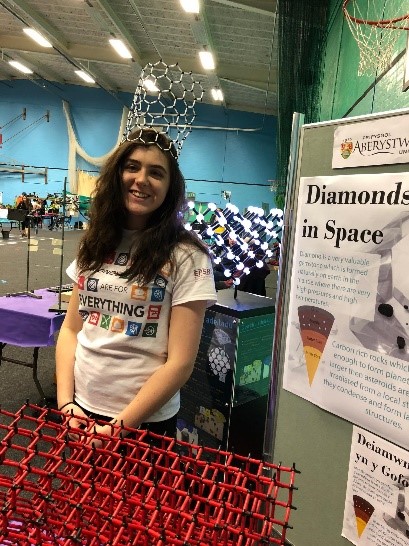News Archive
Platform for Investigation - Diamonds are for Everything
When: Saturday 25th August
Where: Museum of Science and Industry, Manchester
Audience: All ages
What’s going on?: This will be one of our biggest events of the year. The CDT have been invited to MSI to run an event on one of the platform for investigation (PI) days. We shall be bringing all of our best displays and demo’s for a fun interactive day learning about all the best that diamond science has to offer.
Beach Lab 2018
Beach Lab 2018
When: Saturday 30th June
Where: Aberystwyth Bandstand, Marine Terrace, Aberystwyth
Audience: All ages
What’s going on?: The beach lab will return to Aberystwyth bandstand where the Aberystwyth Robotics Club will be showcasing their current projects and a range of interactive entertainment robots. DST students have also been kindly invited to return to put on a stand showing the interesting and unique properties of diamond through several interactive activities.
DST students at the Glasgow Science Festival
Glasgow Science Festival
When: 16th-17th June
Where: Kelvingrove Museum, Glasgow
Audience: All ages
What’s going on?: As part of the Glasgow Science Festival, the CDT have teamed up with the Strathclyde Student Community for Optics, Physics and Engineering (SCOPE) to but on a display at the Kelvingrove Family Weekend at the Kelvingrove Museum. You can come and learn all about how diamond interacts with light compared to other materials, and what in its structure makes it behave this way.
Diamonds in Space - British Science Week Fair 2018

Diamonds in Space - British Science Week Fair 2018, Aberystwyth University
Kerry Hazeldine
As part of British Science Week 2018, Aberystwyth University hosted a 3-day event where students from across county Ceredigion from years 3 to 7 were invited to come along to see what exciting science and research is being conducted at the University and its partners.
Students of the CDT partnered up with students from Aberystwyth University to put on a ‘Diamonds in Space’ stand to highlight diamond research being conducted by the CDT, and diamond science and space science research being conducted in the Physics department at Aberystwyth.
Over the course of the three days’, children were taught about how diamonds are formed on earth in the mantle, how the environment in which they are formed relates to their crystal structure, how the carbon in diamond is different to carbon in other carbon allotropes, and how diamond can be formed in space. One of the interactive activities was to help build a large and growing structure of diamond using ball and stick models; with another activity being able to use the virtual reality headsets to have a look around the solar system and find areas and environments were diamonds could form, i.e. in the asteroid belt.
Over the entire week, approximately 1600 children and adults visited the fair with approximately 400 of those visiting our stall.
Seminar: Diamonds continue to amaze
Diamonds continue to amaze
Jonathan Breeze
Department of Materials, Imperial College London
Tuesday 22 May
1:30pm
MAS 2.06
The solid-state maser, invented in the 1950s, had a far less impressive career than its younger sibling, the laser. This was mainly due to its dependence on cryogenic refrigeration and high-vacuum systems. Despite this, the maser found application in deep-space communications and radio astronomy due to its unparalleled performance as a low-noise amplifier and oscillator. In 2012, the first room-temperature solid-state maser was demonstrated, exploiting the photo-excited triplet state of organic pentacene molecules doped into a p-terphenyl host [1]. Since then, this new class of maser has been miniaturized [2], characterized on nanosecond timescales [3] and shown to exhibit strongly coupled ensemble spin-photon polaritons [4]. However, p-terphenyl has very poor thermal and mechanical properties, and the triplet sublevel decay rates of pentacene mean that only pulsed operation has been observed in this system to date. Alternative inorganic materials that contain spin-defects have been proposed as viable maser gain media, such as diamond [5,6] and silicon carbide [7].
In this talk, I will discuss how the organic solid-state room-temperature maser came about, its subsequent development and how the quest for continuous operation naturally led towards diamond and nitrogen-vacancy centres. I will conclude by reporting the recently demonstrated continuous-wave (CW) room-temperature maser oscillator using optically pumped charged nitrogen-vacancy (NV−) defect centres in diamond [8]. This demonstration unlocks the potential of masers for use in a new generation of microwave devices that could find new applications in spectroscopy, medicine, security, sensing and quantum technologies.
[1] M. Oxborrow, J. D. Breeze, N. Alford, Nature, 488, pp. 353–356 (2012)
[2] J. Breeze et al, Nature Comms, 6 (2015)
[3] E. Salvadori, J.D. Breeze et al, Scientific Reports, 7, 41836 (2017)
[4] J.D. Breeze et al, npj Quantum Information, 3, 40 (2017)
[5] J.H.N Loubser and J A van Wyk, Diamond Research, pp. 11-14, (1977)
[6] L. Jin et al, Nature Communications, 6 (2015)
[7] H. Kraus et al, Nature Physics, 10, pp. 157–162 (2014)
[8] J.D. Breeze et al, Nature, 555, pp. 493–496 (2017)
